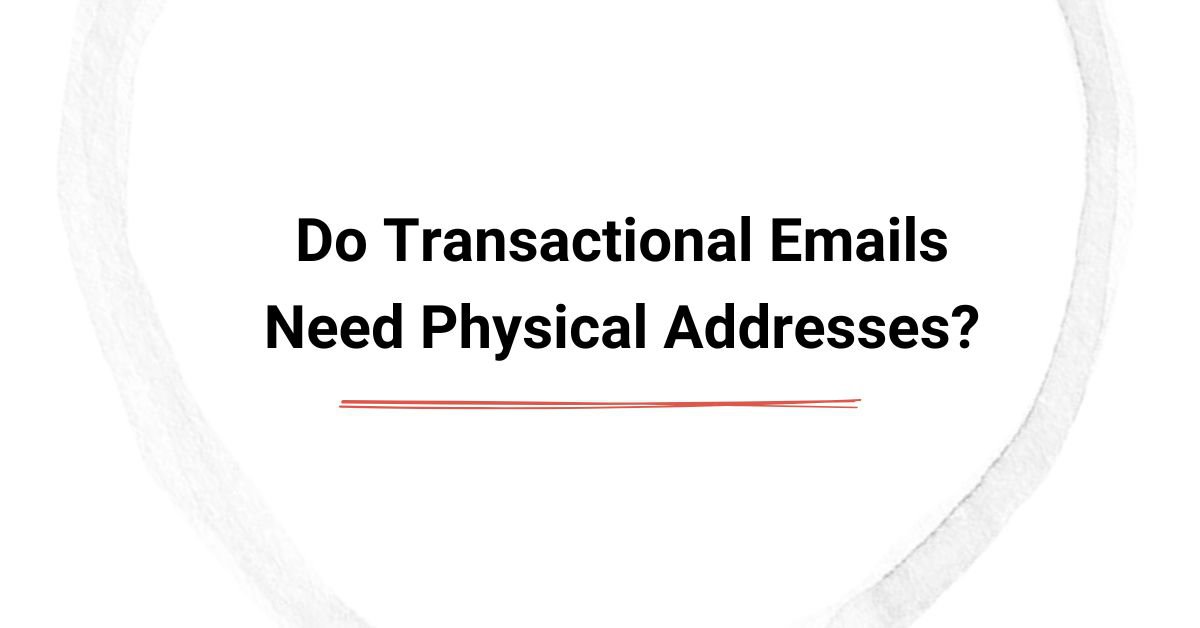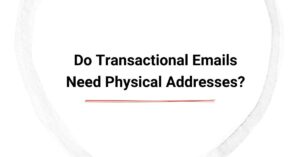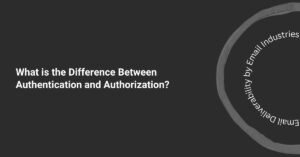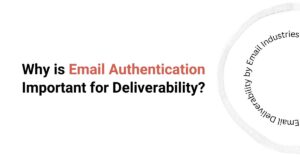When it comes to transactional emails, a common question arises: Do transactional emails need physical addresses? This issue often confuses businesses, especially when navigating the complex world of email compliance. With regulations like CAN-SPAM, GDPR, and CASL shaping email best practices, knowing whether a physical address requirement applies to transactional emails is crucial. Understanding when it's legally required and when it's simply recommended can help you avoid compliance issues while building trust with your recipients.
Many businesses, especially those in SaaS, e-commerce, finance, and healthcare industries, rely on transactional emails to communicate critical information to users. These include password resets, purchase receipts, account alerts, and more. However, determining the physical address requirement for such emails can be confusing, especially when marketing emails and their requirements differ. Let’s get into the details of what’s required, what’s recommended, and how to handle transactional emails properly.
What Are Transactional Emails?
Before we dive deeper into the physical address requirement, it’s important to clarify what transactional emails are and how they differ from marketing emails.
Transactional emails are messages that are triggered by a specific action taken by the recipient. They include important updates like:
- Password reset emails
- Purchase receipts and invoices
- Account alerts and notifications
- Subscription confirmations
Transactional emails are essential for ensuring a seamless user experience. They provide users with necessary information about their interactions with your service. These types of emails often focus on the transactional relationship and aim to provide critical details without the intention to promote a service or product.
On the other hand, marketing emails are primarily used to promote products or services and typically contain a clear call-to-action (CTA), like "Buy Now" or "Shop Today." These emails may include offers, newsletters, or other content that encourages the recipient to engage with a brand on a sales-driven level.
Understanding the distinction between these types of emails is key when considering whether transactional emails need physical addresses. Since transactional emails are non-commercial in nature, they fall under a different set of rules than promotional marketing emails.
For more on the distinction between transactional and marketing emails, check out What Makes an Email Transactional?
What Does the Law Say About Physical Addresses in Emails?
Now, let’s examine the legal aspects surrounding the physical address requirement in emails. The rules governing this issue vary depending on the type of email and the region in which your business operates. Many businesses are unsure of how far they need to go to remain compliant, especially when their emails may be seen by audiences from multiple regions.
CAN-SPAM Act (US)
In the United States, the CAN-SPAM Act sets clear guidelines for commercial (marketing) emails, including the requirement for a physical address in the email footer. However, transactional emails are generally not subject to this requirement.
The CAN-SPAM Act applies specifically to emails whose primary purpose is commercial or promotional. Since transactional emails are meant to facilitate a transaction or provide essential information (like a password reset or an invoice), they are exempt from the physical address rule. The act differentiates between these two types of emails by their primary intent—transactional emails are seen as necessary communications, while marketing emails aim to persuade the recipient to make a purchase.
That said, while it’s not a legal obligation, it’s still recommended to include a physical address in your transactional emails to maintain trust and transparency. This not only keeps you in line with best practices but also reassures customers that your business is legitimate, reducing the likelihood of your email being flagged as spam.
For more on email compliance, check out our article on Email Compliance: CAN-SPAM, GDPR, CASL.
GDPR (EU) & CASL (Canada)
In the European Union, GDPR (General Data Protection Regulation) does not explicitly require a physical address in transactional emails, but it does demand clear identification of the sender. The emphasis is on transparency and the protection of user data, so your email should identify your business clearly. This includes providing essential contact information to establish trust and demonstrate that the sender is legitimate.
Similarly, in Canada, CASL (Canada's Anti-Spam Legislation) enforces physical address requirements for commercial electronic messages, but these regulations apply to marketing emails, not transactional ones. However, if your transactional email contains any form of promotion, it may be classified as a hybrid email (part transactional, part marketing), which would require you to follow the marketing email rules.
For hybrid emails that contain both transactional and promotional elements, it's a best practice to follow the marketing email rules, including adding your physical address in the footer. This gurantees compliance and maintains your professionalism in the eyes of your recipients.
Do You Need to Include a Physical Address in Transactional Emails?
So, do transactional emails need physical addresses? Legally, the answer is generally no, especially in the case of CAN-SPAM and other similar regulations. However, the picture changes when we look at best practices and recommendations.
Legally: Often No
As discussed, there is no explicit physical address requirement for transactional emails under CAN-SPAM and similar laws. These emails are not considered "commercial" or "marketing" in nature, so the regulations that govern marketing emails do not apply. In general, the purpose of a transactional email is to deliver important, time-sensitive information, and its content is not aimed at promoting or selling a product.
Recommended: Yes
Despite the lack of a legal requirement to include a physical address in transactional emails, it is still considered a best practice. Here’s why:
- Build Trust: Providing a physical address can reassure recipients that your business is legitimate and can be contacted easily. This is particularly important for users who may be receiving emails related to financial transactions or sensitive information. A business that doesn’t provide an easy way to contact them could raise suspicions and cause users to hesitate in trusting the email’s contents.
- Compliance for Hybrid Emails: If you’re sending a hybrid transactional email that includes both transactional information and a subtle promotion or upsell (e.g., a post-purchase email with a coupon), it’s safer to follow marketing email regulations, including adding your physical address. This will help you avoid any compliance risks that could arise if your hybrid emails are misclassified as purely transactional.
Following these best practices will help keep your transactional emails professional and in line with legal requirements, while also meeting your recipients' expectations. Adding a physical address, even if it's not strictly necessary, can make a big difference in building trust and showing that your business is transparent and reliable.
Best Practices for Transactional Email Footers
To keep your transactional emails in line with industry standards, here are some best practices for including key details in the footer. Even if a physical address isn't legally required, taking this approach will help you maintain professionalism and build trust with your recipients.
Include:
- Company Name: Always include the official name of your business.
- Contact Email or Link to Support: Make sure recipients know how to reach out with any questions or concerns.
- Physical Address (Recommended): Even if not required by law, including a physical address adds transparency and professionalism.
- Clear, Minimal Text: Keep your footer concise while including all the necessary details. Avoid cluttering it with unnecessary information.
- Avoid Unsubscribe Link (unless hybrid email): Transactional emails should not contain an unsubscribe link unless they include promotional content.
Example: Simple Transactional Footer with Physical Address
Company Name
support@company.com
123 Main Street, City, State, 12345
Example:
Hybrid Transactional/Promo Footer
For a hybrid transactional email that also includes a promotion, here’s an example footer:
Company Name
support@company.com
123 Main Street, City, State, 12345
Enjoy 20% off your next purchase with code SAVE20!
By following these practices, your transactional emails will look more professional and be compliant with industry standards, even if your region doesn’t require a physical address.
Risks of Not Including a Physical Address
Choosing not to include a physical address in your transactional emails could lead to several risks, especially for businesses dealing with international recipients.
- Compliance Risks: Different countries and regions have different rules about what’s required in transactional and commercial emails. Failing to include a physical address in hybrid emails could cause compliance issues.
- Spam Filters: Emails that lack transparency or essential contact information are more likely to be flagged by spam filters. This could prevent your emails from landing in recipients' inboxes.
- Trust Issues: Without a physical address, recipients may question your business's legitimacy, especially if they receive emails with sensitive information like receipts or account alerts.
- User Experience: A lack of transparency could cause users to disengage with your emails, ultimately reducing trust and user interaction.
Template Examples
Here are some email footer templates to use in your transactional emails:
Example 1: Simple Transactional Footer with Physical Address
Company Name
support@company.com
123 Main Street, City, State, 12345
Example 2: Footer for Hybrid Transactional/Promo Message
Company Name
support@company.com
123 Main Street, City, State, 12345
Use code THANKYOU10 for 10% off your next purchase.
These footer templates will ensure your transactional emails are compliant and trustworthy, while maintaining a professional and user-friendly appearance.
Conclusion
So, do transactional emails need physical addresses? Legally, the answer is often no, especially in the case of CAN-SPAM. However, it’s highly recommended to include a physical address in your transactional emails. Not only does it build trust and credibility, but it also helps you avoid potential issues when sending hybrid emails that contain both transactional and promotional content.
By following the best practices outlined in this guide, your transactional emails will be both compliant and effective, ensuring clear communication and a positive user experience.
Book a discovery call to ensure your transactional emails are compliant and trustworthy.









